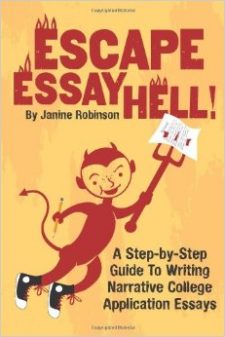
It’s time to let go of the 5-paragraph essay format that most English teachers have pounded into your DNA by now.
College admissions essays are very different from the formal academic essays you wrote in high school.
How?
Well, most are called “personal narratives,” which use the first-person to tell a story or explore a personal insight about yourself or something you value. The majority are written in a more casual style (tone, voice and structure).
Like the 5-paragraph essay, however, they still need to make a “main point,” and they require a structure, although one that is much looser.
Here is one simple technique that can give your essay a structural “spine,” yet keep it engaging and breezy in style.
It’s called Show and Tell (not to be confused with the writing axiom, “Show, don’t Tell.”)
It’s really a simplified version of another writing approach I outlined in an earlier post, called The Ladder of Abstraction.
This is how you do it:When you write, make sure to go back and forth between “showing” the reader your point to “telling” the reader what it means.
Write a Show paragraph, then write a Tell paragraph, then switch back to a Show paragraph, etc. (Most 5-paragraph essays start by Telling, whereas this approach starts with Showing.
When you Show, you are focused and specific, often by providing examples and supporting details.
* * *
When you Tell, you are broad and general, and explain the meaning.
How to SHOW:
- Be specific. (Instead of saying, “The dog was cute.” Say, “The dog, a miniature poodle named Jack, rolled over when you commanded him to ‘Speak!’”)
- Give details. Remember “concrete details”? That just means words that are specific. (Instead of saying, “The trip was awesome,” say “We dove for albacore, built a giant bonfire and road the zip-line ten times.”)
- Use your senses to describe: What do you see, hear, taste, smell and feel?
- Give examples. If you Tell about something, “Everyone was upset by the ruling,” Show them by giving examples of how upset they were, “First, women threw up their hands and screamed. Then, a couple children burst into tears. One man punched the wall.”
- Use anecdotes or “mini-stories” to put the reader in the middle of the action.
- Compare things to make your point. This is another way to Show more clearly what you mean. Instead of, “It was very hot outside.” Say, “It was as hot as a car roof in Arizona.” (Yes, the formal words for these are “similes,” “metaphors” and “analogies.”)
- Zoom in. Like a zoom lens, take a closer look at what you are talking about, show/describe the little things close up.
How to TELL:.
- Be broad and general.
- Explain what something means.
- Summarize a group of smaller ideas.
- Reflect on the larger meaning of something. Look for “universal truths.”
- Analyze what something means.
- Interpret something you wrote.
- Zoom out. Step back from your points and examine the Big Picture.
- When you Tell, you are usually providing “meaning. “What does that mean?”
When you read other students’ sample essays, see if you can spot when they are Showing and when they are Telling. It might make more sense. Then, give it a shot with your own essay.
Check out How to Write a College Application Essay in 3 Steps to get started on your college application essay!
Got questions? I LOVE comments!







Trackbacks/Pingbacks